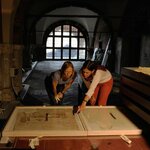Archaeology

Archaeologists and restorers, are preserving and studying 4th-century tunics ascribed to St. Ambrose. In the course of examining the valuable silk garments, they have made surprising scholarly discoveries regarding the development of early relic worship.
Born in Trier, Germany,
Saint Ambrose
began his career as a politician, becoming elected, in 374, the influential Bishop of the emperor’s residence of Milan. He enacted relic worship, and would become frequently quoted in the catechism. The Ambrosian chants are associated with him, and he is honored as a Doctor of the Church. Surprisingly…

In 1934, American archaeologist Nelson Glueck named one of the largest known copper production sites of the Levant, located deep in Israel's Arava Valley, "Slaves' Hill."
This hilltop station seemed to bear all the marks of an Iron Age slave camp – fiery furnaces, harsh desert conditions, and a massive barrier preventing escape, but new evidence uncovered by Tel Aviv University archaeologists overturns that narrative and says the people there were instead highly regarded craftsmen rather than slaves.
In the course of ongoing excavations at Timna Valley, Dr. Erez Ben-Yosef and Dr. Lidar Sapir…

A key part of civilization? Credit: E Photos, CC BY-SA
By Karlena Tomc-Barbosa, Durham University
The discovery of a 4,000-year-old wine cellar in Israel has provided the best direct evidence yet of the raucous, boozy celebrations that were a key part of the region’s culture at the time.
The cellar was found during a recent excavation at Tel Kabri, Israel, described in a new paper in the journal PLoS ONE. In the remains of a palatial storage complex, archaeologists uncovered ceramic jars and fragments of other vessels dating from the Middle Bronze Age, a period which ran from roughly 1900 BC…

A Middle Bronze Age Canaanite palace at the Tel Kabri excavation in Israel has revealed an ancient wine cellar.
Wine production, distribution, and consumption are thought to have played a role in the lives of those living in the Mediterranean and Near East during the Middle Bronze Age (1900-1600 BC), but little archaeological evidence about Bronze Age wine is available to support art and documentation about the role wine played during this period.
During a 2013 excavation, the researchers in this study found 40 large storage vessels in an enclosed room located to the west of the central…

Researchers have discovered new evidence to suggest that the origins of mummification started in ancient Egypt 1,500 years earlier than previously thought.
Traditional theories on ancient Egyptian mummification suggest that in prehistory -- the Late Neolithic and Predynastic periods between c. 4500 and 3100 B.C. -- bodies were desiccated naturally through the action of the hot, dry desert sand.
Scientific evidence for the early use of resins in artificial mummification has, until now, been limited to isolated occurrences during the late Old Kingdom (c. 2200 BC). Their use became more…

Recent papers have suggested that women improve small working groups and so adding women to a group is a surefire way to boost team collaboration and creativity.
A new study from Washington University in St. Louis says that is only true when women there is no competition. Force teams to go head to head and the benefits of a female approach evaporate.
"Intergroup competition is a double-edged sword that ultimately provides an advantage to groups and units composed predominantly or exclusively of men, while hurting the creativity of groups composed of women," said Markus Baer, PhD, lead author…

Excavations at an archaeological site at Kathu in the Northern Cape province of South Africa,
one of the richest early prehistoric archaeological sites in South Africa, have produced tens of thousands of Earlier Stone Age artifacts, including hand axes and other tools.
It is situated between the Kuruman Hills to the east and the Langberge mountains to the west and estimated to be between 700,000 and one million years old.
Steven James Walker from the Department of Archaeology at the University of Cape Town, lead author of a new paper about discoveries from the site, says, "The site is amazing…

An archaeological dig in southeast Turkey has uncovered a large number of clay tokens that would ordinarily been have dated before the invention of writing - but the new find of tokens dates from a time when writing was commonplace, thousands of years after it was previously assumed this technology had become obsolete.
Sound strange? Perhaps not. Researchers compare it to the continued use of ink pens from the early 1800s in the age of computers.
The trade tokens are small clay pieces in a range of simple shapes and were likely used as a rudimentary bookkeeping system in prehistoric…

Skeletal remains uncovered near the site of a Roman villa in Dorset are likely the five skeletons of the owners and occupants of the villa – the first time in Britain that the graves of villa owners have been found in such close proximity to the villa itself.
The five skeletons were two adult males, two adult females and an elderly female – with researchers postulating that they could be the remains of three generations of the same family, who all owned the villa. The bones are thought to date from the mid-4th Century (around 350 AD).
The discovery was made by staff and students from…

Forty-eight centuries ago, a bronze-age settlement flourished on the southern coast of Peloponnese, about 30 miles south of what would two thousand years later become the important town of Sparta. The city had a harbour facing east on calm waters, and had a few dozen buildings, roads, a burial site, and probably more. We do not know its ancient name, so the place has been called with the name of the modern-times place, Pavlopetri.
Five thousand years later, we know about the ancient settlement because of a cataclismic event: a powerful earthquake, probably around the year 1000 BC (or maybe a…